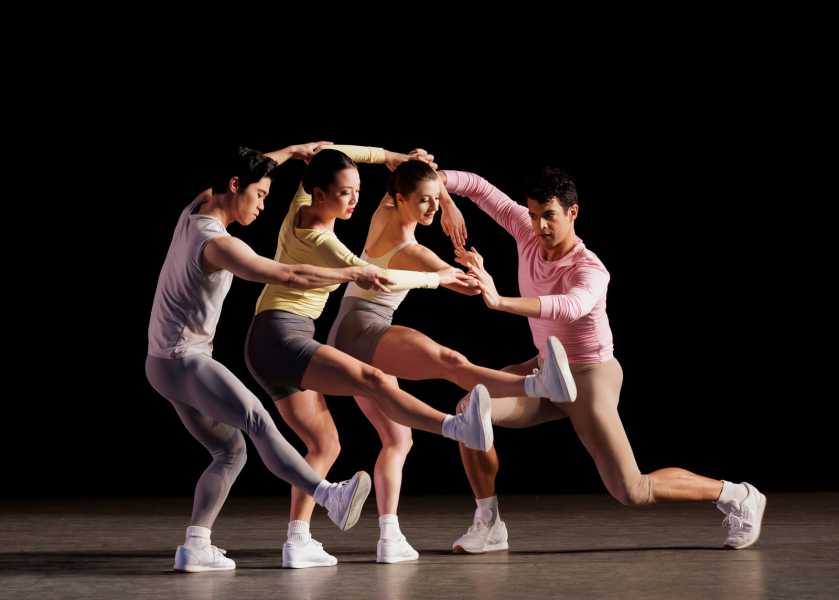
Save this storySave this storySave this storySave this story
Helen Shaw
Staff writer
You’re reading the Goings On newsletter, a guide to what we’re watching, listening to, and doing this week. Sign up to receive it in your in-box.
Catching the fleeting international theatre offerings in New York can be like chasing after fireflies—the minute someone points out some wonderful work, the brief engagement is already dark and gone. These are the shows most worth the hunt, though; some of the world’s most adventurous, exhilarating, and galvanizing work will be in town for only a couple of days.

Illustration by David Huang
To catch the best of these rare finds, focus on a few theatres: Brooklyn Academy of Music, N.Y.U. Skirball Center (which has a superb season over all), and Japan Society, which kicks off its “Ningyo! A Parade of Puppetry” series with a remounting of “Dogugaeshi” (Sept. 11-19), Basil Twist’s spectacular 2003 collaboration with the shamisen composer Yumiko Tanaka. The small-is-powerful lineup operates as a portal to other realms: Twist’s micro-masterpiece is named for a Tokushima tradition of intricately sliding painted panels that trick the eye, and one of the other offerings, a long-awaited visit from Japan’s National Bunraku Theatre (Oct. 3-5), includes scenic design by Kazuo Oga, the art director of “Princess Mononoke.”
Meanwhile, at N.Y.U. Skirball, you’ll find Milo Rau, a Swiss director who is the most influential artist working in political theatre today—“My leadership model is a permanent revolution,” he has said of his several artistic directorships. His “Antigone in the Amazon” (Sept. 27-28) refracts Sophocles’ story of state murder through the true events of the Brazilian Landless Workers’ Movement massacre, in 1996.
Skirball is also participating in the multi-venue “Crossing the Line” series (a project of L’Alliance New York, through Dec. 7) this year, so you’ll find several of the wide-ranging festival’s projects there. I’m particularly dizzy over the chance to see the Belgian creator Miet Warlop’s superhit “One Song” (Skirball, Oct. 3-5), in which a company performs a single song over and over while undergoing escalating tests of endurance, and Marlène Saldana and Jonathan Drillet’s “Showgirl” (Skirball, Oct. 18-19), which uses delulu cabaret exuberance to reinterpret Paul Verhoeven’s so-bad-it’s-opera movie from 1995. The unifying factor seems to be intensity—many of the offerings emphasize that we are in a moment of hot iron, when something must be struck. Only Tiago Rodrigues takes this to its grim but logical extreme: his “Catarina and the Beauty of Killing Fascists” imagines a Portuguese family with a tradition of conscientious violence. If you can bear thinking about such things, the show will be at BAM Nov. 13-17.

About Town
Classical
Anthony Roth Costanzo’s rambunctious, head-spinning, hundred-minute version of “The Marriage of Figaro”—in which the countertenor Costanzo sings every part—approaches Mozart’s comic masterpiece like a golden retriever approaches a Frisbee. Tackling the opera’s challenges with palpable gladness, Costanzo sings the servant Figaro, his betrothed Susanna, and a whole palace worth of erotic schemers, as virtuosic lip-synching performers act out the scenes. Aided (abetted?) by the director Dustin Wills and the arranger Dan Schlosberg, Costanzo piles wonder on wonder: for instance, somehow, in “Riconosci in questo amplesso,” six voices soar out of one man (and his looping pedal). Later, Costanzo and his avatar-Susanna, Emma Ramos, commune ecstatically—it’s the “marriage” Costanzo seems most interested in, of song to body, music to flesh.—Helen Shaw (Little Island; through Sept. 22.)
Art
There are only five black-and-white photographs, two hefty, incised limestone blocks, and a video in Mark Armijo McKnight’s museum début, but their effect is far from minimalist. If the work comes with a lot of conceptual baggage, you don’t have to bone up on Simone Weil to appreciate the artist’s meditation on time, death, the body, and the beauty of a desolate landscape. A female nude opens her legs wide in a field of tiny daisies, an earthy take on Courbet’s “Origin of the World” that suggests fertility and rebirth, balancing an image of the skeleton of a mountain goat nearby. In the wall-filling video, synchronized metronomes tick away on the ledges of the New Mexico badlands, as relentless as the wind on the soundtrack, as reassuring as your heartbeat.—Vince Aletti (Whitney Museum; through Jan. 5.)
Hip-Hop

Photograph by Vivian Khanounsay
The Charlotte rapper Mavi was exploring neuroscience at Howard University when his 2019 début album, “Let the Sun Talk,” opened a doorway to a different kind of sensory study. His music was both curious and stimulated, as clearheaded and philosophical as it was intuitive, unfurling before the listener as knots of spiralling rhymes touched by soul. His rich 2022 follow-up, “Laughing So Hard, It Hurts,” delved into familial loss, addiction, and trying to stay steady amid an ego-inflating rise. His latest, “Shadowbox,” is a plaintive album of gutting self-scrutiny that takes his flows to new depths. “I don’t think failure scare me as much as my talent,” he raps, pointing to an existential challenge.—Sheldon Pearce (Music Hall of Williamsburg; Sept. 12.)
Theatre
Two years after a breakup, your ex reaches out, wanting to get dinner. It’s a dubious proposition, both in real life and as a dramatic premise. But Douglas Lyons’s world-première play “Table 17,” which moves to a rhythm all its own, confounds expectations. The reconnection of Jada (Kara Young) and Dallas (Biko Eisen-Martin) is interlaced with scenes of their relationship’s defining moments, much as their heated dialogue is punctuated by tender asides. The pivoting works thanks to a talented cast—particularly Michael Rishawn, who turns several supporting parts into a larger-than-life presence—and to Zhailon Levingston’s inspired direction, which treats the fourth wall like a door. Everyone involved seems to have chemistry.—Dan Stahl (Robert W. Wilson MCC Theatre Space; through Sept. 29.)
Dance

Justin Peck’s “Partita.”Photograph by Erin Baiano
When George Balanchine and his friend Alexandra Danilova were young dancers in pre-Revolutionary St. Petersburg, they performed in the rousing Mazurka in Act I of “Coppélia.” Many years later, in 1974, Balanchine asked Danilova to help him stage a new version, for New York City Ballet. The production—sweet and funny and packed with dance—turns fifty this year, and will be presented during the fall season, which also includes an all-Justin Peck program, to mark his tenth anniversary as choreographer in residence; new works by the young choreographers Gianna Reisen and Caili Quan; and the company première of a lyrical pas de deux for two men, “Each in Their Own Time,” by the veteran dancemaker Lar Lubovitch.—Marina Harss (David H. Koch Theatre; Sept. 17-Oct. 13.)
Movies
In the daring and inventive documentary “The Mother of All Lies,” the Moroccan filmmaker Asmae El Moudir’s fine-grained exploration of family history yields revelations of large-scale historical crimes. Frustrated in her search for childhood family photos, she learns that they were destroyed by her grandmother, who has an obsession with secrecy, and whose ferocious presence dominates the film. In order to reimagine the suppressed past, the director calls upon her father, a skilled craftsman, to construct figurines of the family and friends, plus a diorama-like set of the neighborhood. This restaging brings to light long-silenced memories of a government massacre of strikers, in 1981; El Moudir makes clear its devastating effect on the family, the community, and the country at large, and gives voice to repressed trauma and grief.—Richard Brody (In limited release.)

In the Neighborhood
Jackson Arn on Prospect Heights.

Illustration by Josh Cochran
Earlier this year, I realized that most of the art critics I know live a few blocks from me in Prospect Heights. This may strike you as a good reason never to set foot here again, but I promise we haven’t ruined everything. If I had to stake my neighborhood’s reputation on one item, I’d choose the barbecue-shrimp sauce at Lowerline, a Creole restaurant artery-threateningly close to my apartment. Notice that I didn’t say the shrimp, which is excellent but mostly a way of ingesting the dark nectar of Worcestershire, black pepper, and butter it comes soaked in. If you don’t sop everything up with French bread you are allergic to either gluten or happiness. As long as I’m on the subject of bloat, allow me to say a few words about Nereus. You know, the Greek sea god? Son of Pontus and Gaea? Yeah, I wasn’t too familiar with him, either, but there he is, compliments of the sculptor Eugene Savage, on the southern side of the Bailey Fountain, at Grand Army Plaza. Leonardo thought that Michelangelo made flesh look like a sack stuffed with nuts; Savage makes it look like a Boar’s Head ham bulging through its string casing. He even makes Nereus’s beard look this way, and although that may not be everyone’s idea of sublime artistic achievement, it is decidedly mine. Culture Fusion Books (I didn’t know the name until I wrote this—to me, it’s always been That Place on Washington) is run by a preternaturally kind woman named Patricia, who asks great questions and tells better stories. Most of her merchandise is stacked, not shelved, into dusty Jenga towers with some mysterious architectural and organizational logic. Before I moved to New York, I imagined bookstores like this on every street, but I’ll settle for the one.
P.S. Good stuff on the Internet:
- “The Crane Wife,” by CJ Hauser
- Laufey’s Tiny Desk concert
- W. S. Merwin on September
Sourse: newyorker.com






